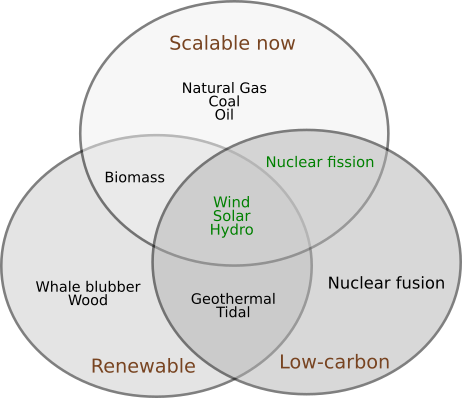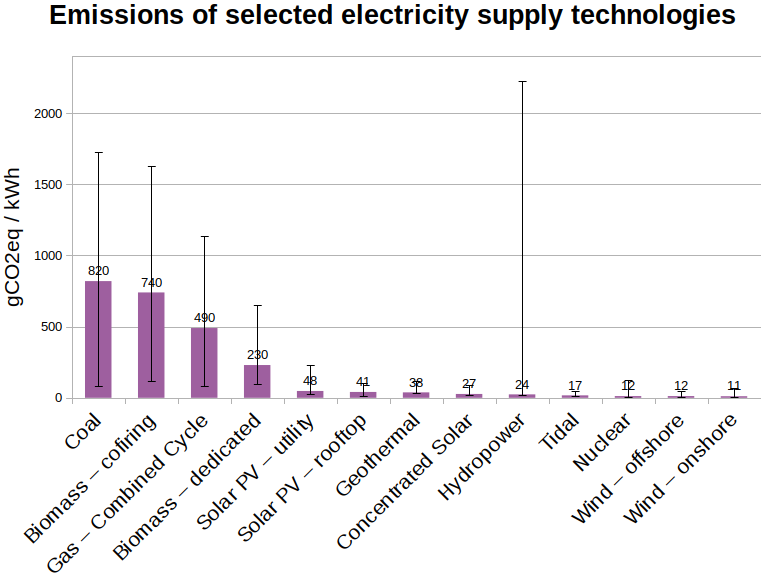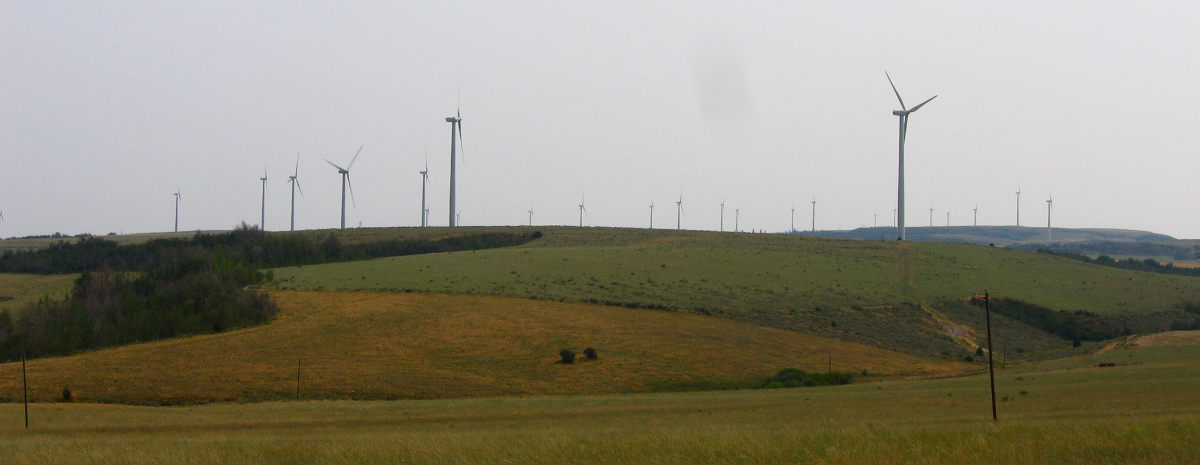100% renewables can be inadvertently anti-nuclear
By Nick Touran, Ph.D., P.E., 2018-02-19 , Reading time: 8 minutes
Pop quiz: what’s the difference between renewable and sustainable energy? The answer is nuclear energy. Behold:

Today, the world is powered 85% by fossil fuels and we’ve realized this isn’t great for a sustainable future. So we want to switch to things that will power our lives without harming the environment. Lots of people have opinions about best choices, but if we agree that atmospheric carbon is the problem, then this simple graph1 shows our options:

Nuclear is already making 60% of the clean, carbon-free energy in the USA. It is our current climate champion.
There’s been a strong anti-nuclear movement for many decades. As climate change became a problem, many of them made the switch and started supporting nuclear because it’s extremely low-carbon.
- Pandora’s Promise is a movie about people making the switch.
- James Hansen, famous climate scientist, became strongly pro-nuclear.
- James Lovelock, who originated Gaia Theory, has become strongly pro-nuclear.
- Patrick Moore, co-founder of Greenpeace, has become pro-nuclear (before he started denying climate change outright, but that’s another story).
- Author Gwyneth Cravens documented her switch to being pronuclear in the book Power to Save the World
- Recent movie The New Fire is all about millenials starting nuclear companies to combat climate change.
A lot of momentum and support for nukes grew because of climate change. That’s certainly how I got into nuclear!
The awesome rise of the intermittent renewables

Fortunately for the world, the cost of solar panels, wind turbines, and batteries has been falling dramatically. This is extremely good news and comes at a pivotal time for humanity. We need to be putting solar panels on every roof and wind farms wherever they make sense. We need to install lots more hydroelectric turbines on existing dams and build new reservoirs for pumped energy storage where it makes sense to do so. We need huge fleets of electric vehicles plugged into smart-grid infrastructure that can give excess stored energy back to the grid when the wind dies (65% of the time on average in the USA) and when the sun isn’t shining (75% of the time on average in the USA). All of this is essential. We’re now 3% powered by renewables, and this fraction is increasing rapidly.
The folly of 100% renewable
With all the good news about renewables, it’s easy to take it to the next level and say hey let’s just target 100% renewables! On the surface, this feels and sounds good and a lot of people get onboard with this, not fully considering the nuance. And powerful anti-nuclear groups smell blood and are running with it, pushing for 100% renewable policies and tax breaks.
On its own that’d be fine but a silent victim of this is nuclear energy. Operating on the margin alongside cheap fracked natural gas, renewable tax-credits push nuclear operating costs into the “I could make more money if I just burned natural gas” regime for many utilities. This is leading to the early shutdown of some nuclear plants in the USA to the major detriment of the climate. Most nuclear plants are operating in the northeast of the country, where solar doesn’t have too many large-scale projects coming online that can replace them, especially in polar-vortex winters. So they’ll be replaced by fracked natural gas, a big step backwards.
Anti-nuclear individuals and groups know that utilities care mostly about cost, so they promote policies that discriminate against nuclear specifically by using the word renewable. If we want to promote clean, carbon-free energy, then we should do so without discrimination, and call it a clean-energy or low-carbon policy.
We need all the sustainable energy we can get, including vast amounts of wind and solar (I envision 50% of total energy being produced by these). If you care about these things you should promote and support all of them, including nuclear.
If you’re a climate pragmatist and you see a renewable-only bill, tell your policy makers that you care even more about the environment and you’d like to see all carbon-free sources included, including nuclear. You know you can’t let your old biases get in the way of a clean-energy future.
Indeed, probably the most straightforward way to be pragmatic in this is to support a carbon tax. This will lift renewables and nuclear for the right reasons and targets exactly what the problem is, while putting a price on externalities of fossil fuel. So let’s get a carbon tax going!
If you don’t support nuclear energy, that’s fine. Just say that you support all carbon-free energy sources except nuclear and that you’re confident we can accomplish our climate goals without the single biggest carbon-free energy source in the USA. Don’t euphemize it as 100% renewables. Also keep in mind that to meet the Paris goals we need to be totally carbon-zero by 2050 worldwide and then use vast amounts of excess clean energy to suck carbon out of the atmosphere. And say that you’re confident that truly vast amounts of energy storage can be built with no serious environmental or economic footprint. I haven’t heard anyone say renewables will be “too cheap to meter” but I think we’re very close to hearing someone say that, and we all know where that ends up. I won’t say it’s impossible but I will claim that this is a serious challenge.
This stuff is hard. We can do it but it’s hard. We need all the help we can get.
Common myths put forth by 100% renewables proponents
Here are some misleading things people frequently point to when promoting 100% renewables while slyly being anti-nuclear.
Nukes can’t be built quick enough.
I’m just going to leave this quote from a NREL scientist promoting solar here:
Rapid growth and transition has occurred previously for new, capital-intensive technologies in the electric power sector. In the 15-year period between 1972 and 1987, more than 85 GW of new nuclear generation was constructed in the United States, with more than 5 GW per year constructed during 9 of those 15 years
France achieved a similar build-out rate when they electrified their whole grid with nukes. Don’t tell people this can’t be done. It can be done.
Nukes aren’t safe
Demonstrably false. Nukes are among the safest energy source we know, with very few deaths caused per watt-hour generated. Even considering Chernobyl and Fukushima, nukes have saved millions of lives by displacing air pollution. It’s hard to believe this due to the anti-nuclear movements fear, uncertainty, and doubt, but it’s true. The UN and WHO reports on Chernobyl are solid, and those who deny them commit the same anti-science mistake that climate science deniers make against the same institutions. In some estimates, more people die installing solar panels on roofs than have died due to nuclear energy.
Nukes are too expensive
This is currently true in the US and France, for sure, and the nuclear industries there need to figure out how to build and operate plants significantly cheaper to be players in the game. Advances in things like Small Modular Reactors that can be factory-produced a ‘la Henry Ford are in advanced development and may be able to help here a lot. Meanwhile in Korea and Russia, true serial production of nukes has been achieved and they can build them on time and on budget consistently. It can be done.
Nuclear waste is an unsolvable problem
So defeatist! We have a whole page on that. Basically, we know what to do with the waste: put it in a deep geologic repository. Since nuclear energy is so dense, you only produce a soda can of it in your lifetime if you’re 100% nuclear. It’s dangerous stuff but we definitely can properly and safely dispose of it. No one’s ever been hurt by commercial nuclear waste.
Conclusion
Let’s get all the clean, low-carbon energy sources together and power humanity in a responsible and sustainable way. There’s no time to fight about the details, we just need low carbon. Let’s do it!